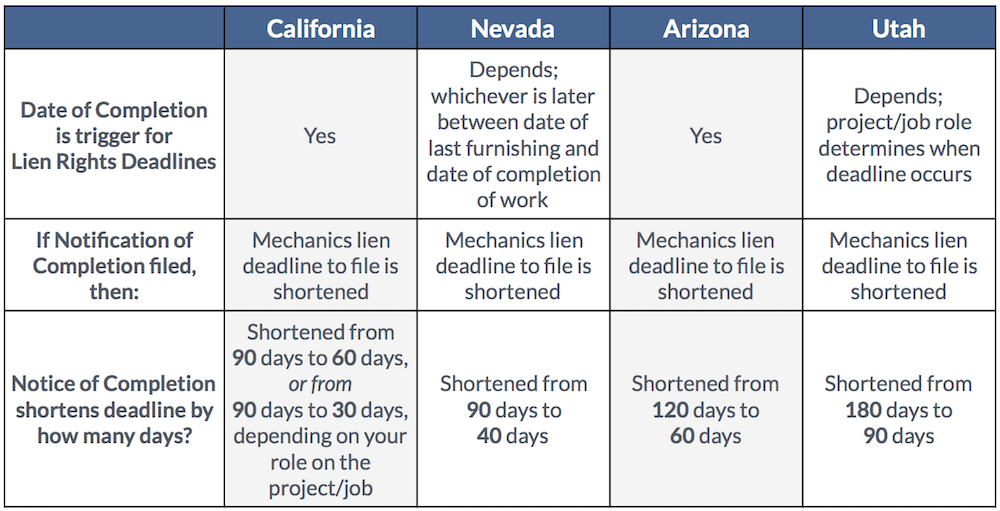
As anyone reading this surely knows, the construction industry loves its documents! There’s a document for just about everything under the sun in the construction business. When it comes to securing payments in the construction industry, not only is there a specific document required for each step in the process, the name of that document also varies from state to state. There are some documents that are only used in one or a few states. The document we’re discussing today is the “Notice of Completion” or “Notice of Cessation.“
But when do you see Notices of Completion, and why are they important to you? Continue reading to find out.
Notices of Commencement are different. Were you looking for information on the Notice of Commencement document?
What is a Notice of Completion?
A Notice of Completion Is:
A document recorded by a property owner to notify potential mechanics lien claimants that a specific construction project has been completed. The effect of a properly recorded Notice of Completion is to reduce the time in which a subcontractor, material supplier or general contractor can record a Mechanics Lien against a private works construction project. ~ Beard Hobbs, Attorney at Law
There are some important things to note from Mr. Hobbs’ definition. The Notice of Completion typically comes from the property owner on a private project to notify the participants on a project – specifically, the parties that have Mechanics Lien Rights – that the project has been completed. Other parties higher up on the payment chain, like prime contractors or general contractors, can file a Notice of Completion too.
Here’s the bottom line. When an owner files a Notice of Completion, the mechanics lien deadline is shortened.
Where Does a Notice of Completion Matter for Private Construction Projects?
In the vast majority of states, the deadline to file a mechanics lien is based on the “last furnishing methodology,” or the date that a participant – subcontractor, sub-sub, material supplier, or equipment lessor – last supplied labor or materials to a construction project. However, there are 5 or 6 states where lien rights deadlines are tied to the date when a project is substantially or finally complete. Four of those states – California, Nevada, Arizona, and Utah – are neighbors of one another out west. And in those 4 states, the owner may file a Notice of Completion which can drastically shorten the deadline available to file a mechanics lien.
The table below outlines the basics regarding the date of completion trigger. It also covers what happens if an owner files a Notice of Completion in one of these 4 states.
Note: Tennessee, Massachusetts, and Alaska are also states where an owner may file a Notice of Completion.
What’s the Safest Course of Action?
The safest way to calculate a lien claim deadline in one of the 4 states listed above is to follow your last furnishing date or date of last work of improvement. Here’s why:
- The completion date on a project is often difficult to find out, but your last furnishing date will be obvious to you, since you’re the one who did the furnishing.
- Chances are the project continued for some time after your last day on the project (your last furnishing date)
- Therefore, since the date that you last furnished work or materials will almost always be earlier than the date that the project is substantially or finally complete, basing your deadline to file off of your last furnishing date should give you the “completely safe lien period.”
Notices of Completion in the State of California and Arizona
If you live in California or Arizona, there’s a simple way to protect your right to file a mechanics lien. Furthermore, it’s something you should do on every project anyways. Always file a preliminary notice, and send the notice to every party on the project. In most states, the best delivery method is certified mail.
In California and Arizona, property owners need to send the Notice of Completion to the parties who submitted preliminary notices. This is especially important if you’re a subcontractor. Having said notice in-hand allows you to plan accordingly and avoid complications with a shortened mechanics lien deadline.
You can find these pieces of legislation here: Arizona § 33-993 and California § 8190.
See:
Arizona Notice of Completion FAQs
California Notice of Completion FAQs
Read more here: How Do You Know If a Notice of Completion Was Filed on a Project?
What Else Should I Know About Notices of Completion?
Lastly, you should know that you may encounter Notices of Completion even if your state’s construction law doesn’t require them.
If there’s a construction lender on the project, they may require the direct contractor or the general contractor to file a Notice of Completion with the county recorder to indicate the completion of the project. In some cases, this date of recordation could influence the deadline to file a lien.
Conclusion
To sum it up, regardless of whether or not the project owner, prime contractor, general contractor, or any other party higher up the payment chain files a Notice of Completion, you need to be aware.
Always calculate your lien deadline based on the completion of the work (last furnishing), always send a preliminary notice, and always make sure you have your finger on the pulse of the construction project. Otherwise, a shortened mechanics lien could seriously burn you.

